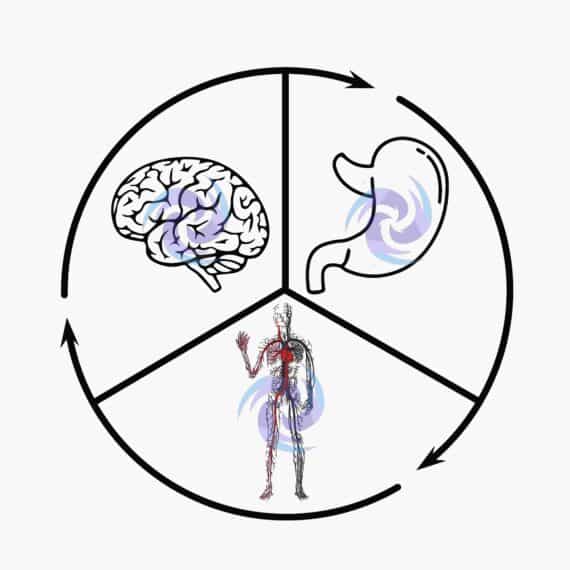
In Part 1, we looked at the two major ways humans process energy – through our automatic systems and the systems that support our freedom of choice – and how each of these works.
Next, we will consider how the energetic level of our brain, stomach and blood system together are the three ringleaders of the addiction cycle. These systems can get automated by the repetitive and ongoing use of an addictive substance – which essentially hijack these systems to perform in a different way from their natural design and thereby giving power to the addiction cycle.
Let’s break it down what an addiction cycle is:
The National Institute of Health defines addiction as: “a chronic, relapsing disorder characterized by compulsive drug seeking and use – despite adverse consequences. It is considered a brain disorder, because it involves functional changes to brain circuits involved in reward, stress, and self-control.”
And, simply put, any event that is regularly repeated in the same order constitutes a cycle like spring, summer, fall, winter or Monday, Tuesday, Wednesday and so on.
Putting these two together, an addiction cycle is a process that a person has established in their automatic systems to continue a certain, usually euphoric, feeling or state. There then comes a point at which the person is no longer the decision maker and, instead, the substance and the person’s automatic systems are in control – leaving the person’s conscious choice out of the decision loop. This is the ‘chronic relapsing disorder’ part of the addiction cycle.
The three ringleaders: brain, stomach, blood
To delve deeper into the addiction cycle, let’s look at each of the ringleaders and how they work in conjunction and in combination with each other.
Our brain conducts highly essential functions, including providing signals to the many automatic systems that maintain our life such as our digestion, as one example. It’s an incredibly advanced organ and in along with our soul, is designed to make innumerable, extremely precise calculations on our behalf. Imagine every single calculation needed to perform a simple task like sending all the correct signals to our hand when we wish to take a sip of water from a glass. The number of nerves, muscles, tendons and all the other parts involved in this simple action is enormous, and yet it all happens smoothly and flawlessly without a single thought about the complexity of the mechanics.
Yes, our brain is amazing. But it also can be our own worst enemy – if we hand over too much power and allow it to be in the driver’s seat of our life. Because after all, that’s our job! You are not your brain.
From an energetic standpoint, our brain naturally has a huge affinity to fly high. It prefers to process what it considers ‘high octane fuel’ because it makes it feel better and more alive. It loves excitement and new experiences, and it’s completely reliant on us to provide this stimulus.
It’s the part of us that goes to the county fair and says, ‘I want to go on that ride!’ We’ve taught our brain what energies are exciting for it all our lives. And, in return, it can do a multitude of functions on demand. Our experiences reflect directly on how our brain gets wired, and this plays out and affects us every single day.
The brain can also be really bossy, especially when it needs an excitement fix. This is why it’s so important to have worked out a direction and purpose in life. Otherwise – without healthy parameters – our brain will have us floating from one excitement to another, and the art of living life is nonexistent because we abdicate living to our brains. It’s easy to see how the brain can get hijacked by an addictive substance or behavior because of its love for flying on high-octane fuel.
The next ringleader, our stomach, helps to digest and break down physical foods but also plays a big role in the addiction cycle. The stomach can also be referred to as the ‘Moving Center’ energetically speaking because it’s responsible for movement and everything we do repetitively.
As our brain loves to fly high, our stomach loves repetition.
It feels most comfortable when we’re doing things that it already knows how to do. Our stomach doesn’t like surprises like our brain does. The brain gets excited when it can do new things. The moving center or stomach loves it when you settle in to watch a good movie with a bowl of popcorn. It thinks this is heaven.
The stomach has its own way of trying to exert control over our life. It can cause you to mindlessly play video games for hours on end. It does this in cahoots with our brain because the brain gets excited when we win! Our stomach loves the repetition of the game and distracts us so that we forget about time and end up finding ourselves late for an appointment or delaying tasks we promised ourselves we’d accomplish.
We can train our automatic systems to work with us or allow them to take over.
If we allow our stomach to do what it wants all the time, it becomes quite resistant to change. It won’t like it if you try to implement new disciplines; it will require a greater conscious power of repetition to create new patterns. This absolutely can be accomplished, but it takes time, focus and patience to establish these new patterns.
Everything that the brain and stomach do on a repetitive basis gets recorded in our blood systems energetically. Our blood works like the tape recorders we used before digital recordings took over.
So how did these old tape recorders work? The Encyclopedia Britannica explains it simply: “As the tape moves past the recording head, the powder is magnetized in such a way that the tape carries a record of the electric signal. On playing back the tape past the recording head, the signal is reproduced and then converted through a loudspeaker into the original sound wave.”
What? Our blood records stuff?! How does that work? Like the tape, our blood also has a magnetic ability to record and hold that electro-magnetic signal. The magnetic ability comes from the micronutrient of its iron content. Iron is one of the most common magnetic metals around and is utilized by many organs and metabolic processes, including our blood system.
So yes, our blood records and maintains the many patterns we establish by whatever we do repetitively, thereby creating specific electro-magnetic patterns in our blood. Our stomach helps to establish these blood patterns because of its ability to implement the action, and then the blood records those actions and stores them until the moving center calls on the blood to replay that pattern. The more times the action or thought is played out, the more deeply imprinted the blood pattern becomes thus creating a particular habit.
Everything that we say, do, think, long for, love, belong to, believe in gets recorded in our blood and then the blood informs every single cell in our body repetitively as it circulates through every part of us, which then radiates outwardly into our bio-energetic field.
We can choose to superimpose over an unwanted blood pattern or habit using our automatic systems in a conscious way and imparting new ways and habits that we choose instead, repetitively, on a consistent basis, with the power of our conscious thought. This works for some, but others with substance use disorder may need help.
And that’s where the Weiss Method comes in.
The Weiss Method offers a non-invasive, one-on-one treatment using no medication, needles or hypnosis. This energy-based treatment cleans and rebalances the systems at the root cause, freeing the person by interrupting the addiction cycle.




